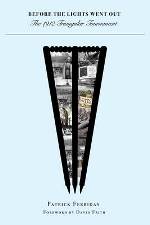Before the Lights Went Out : The 1912 Triangular Tournament
Martin Chandler |Published: 2011
Pages: 327
Author: Ferriday, Patrick
Publisher: Von Krumm Publishing
Rating: 4.5 stars

It is not uncommon for cricket writers to produce books about past Test series. Generally the best of these are written from a distance in time where there is at least some primary source material available from individuals for whom the events occurred within living memory. It is more difficult for authors to delve back beyond the point where there are no personal recollections, and in recent years authors like Peter Sharpham, Peter Sheppard and Alfred James have all, despite exhaustive research, struggled to bring Ashes series from the Victorian era to life. That is not to say that such a task is impossible, as reading David Frith’s fine retrospective account of the 1894/95 Ashes series, Stoddy’s Mission, amply demonstrates, but a lack of first hand testimony is a distinct disadvantage.
I first learned of Patrick Ferriday’s plans to write a book about the 1912 Triangular Tournament a couple of years ago. It immediately struck me as an excellent idea, although not one I was entirely convinced he would be able to make a success of. A positive consideration was that, as still the only such event ever staged, there was considerable interest merely by virtue of that fact alone. In addition the matches were the last Tests to be played in England before the international game stopped for the duration of the Great War. That appalling conflict finally brought the “Golden Age” to its conclusion and accordingly an examination of the Triangular Tournament provided an opportunity for a valuable and interesting digression. On the other hand a combination of the South African tourists proving a disappointment, and the Australians being seriously understrength as a result of one of the game’s more colourful controversies, when taken together with a wet English summer, meant that little of the cricket was particularly memorable.
It was therefore with some trepidation, as well as eager anticipation, that I first opened Before the Lights Went Out. I had already gathered a flavour of what to expect from the website that had been up and running for some time. I knew that there were three distinct parts to the book. Part one involves a study of the developement of international cricket and how the tournament came about. Part two is a detailed chronicle of the events of 1912, both on and off the field, and finally Part three contains an examination of the aftermath and legacy of the Tournament.
The first part of the book is superbly crafted. It cannot have been an easy task to decide how detailed this should be, and indeed just what aspects of the histories of cricket, and of the three competing nations should be covered. What was of particular concern to me was that the narrative might simply travel down a similar path to that taken by other authors in the past. I should have had more faith – Ferriday successfully accomplishes his mission and while some of the cricketing aspects of the story were, inevitably, not new to me, the knowledge that I acquired about the prevailing social, economic and political issues in Great Britain, Australia and South Africa, was of enormous assistance in appreciating the book as a whole.
Part two has clearly been as painstakingly researched as Part one, and while Ferriday is inevitably indebted to EHD Sewell, who wrote the only contemporary account of the Tournament, he has gone well beyond Sewell’s writings in his efforts to gain additional insights into the events of the summer. The match descriptions themselves are certainly thorough, and while they do not come to life in quite the manner that David Frith achieved in Stoddy’s Mission, they are far from bland and, in fairness to Ferriday, Frith did have some rather more exciting cricket with which to work.
In many ways the final part of the book is the most interesting. Ferriday’s reflections on the Tournament are well thought out and eloquently presented, and the glimpses into the future are all relevant and help to put all of the events that the book covers in context. In particular the brief sketches of the remainder of the participants’ lives, a number of which were, tragically, destined to be fairly short, answered the few questions that had occurred to me, and not been dealt with as I read the preceding chapters.
In reaching a conclusion about Before the Lights Went Out I suppose I should preface my remarks by admitting that books that allow me to read about the game’s history are always well received. I also have a great deal of respect for authors who, like Patrick Ferriday, spend years working for my benefit on projects that illuminate dusty corners of the game’s past where few have ventured before. Having declared that interest I have no hesitation in saying now that when we come to assess the candidates for 2011’s book of the year, that Before the Lights Went Out will be there or thereabouts. It is a comprehensive, well illustrated and, in view of the last minute difficulties that Ferriday encountered, impressively produced piece of work. If you are one of those cricket lovers who, like me, has always found the “Golden Age” beguiling, then Before the Lights Went Out is essential reading. It is highly recommended and you can read an extract from Part one here .






Leave a comment